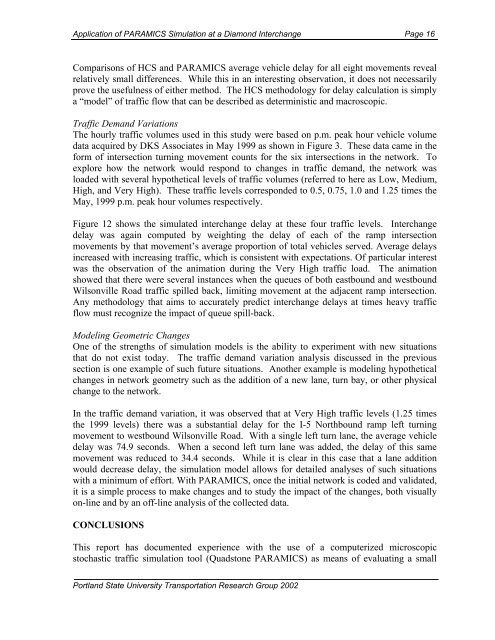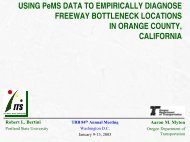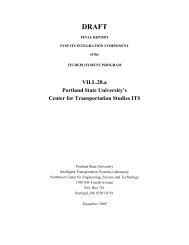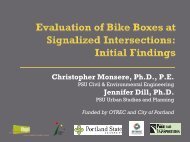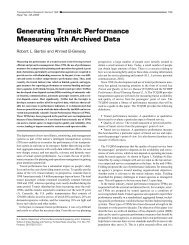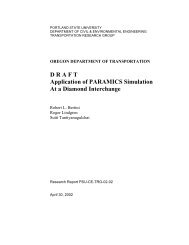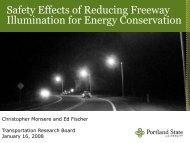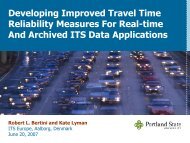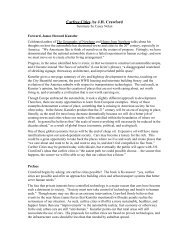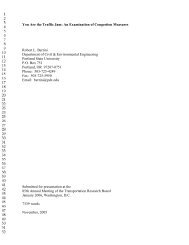D R A F T Application of PARAMICS Simulation At a Diamond ...
D R A F T Application of PARAMICS Simulation At a Diamond ...
D R A F T Application of PARAMICS Simulation At a Diamond ...
You also want an ePaper? Increase the reach of your titles
YUMPU automatically turns print PDFs into web optimized ePapers that Google loves.
<strong>Application</strong> <strong>of</strong> <strong>PARAMICS</strong> <strong>Simulation</strong> at a <strong>Diamond</strong> Interchange Page 16<br />
Comparisons <strong>of</strong> HCS and <strong>PARAMICS</strong> average vehicle delay for all eight movements reveal<br />
relatively small differences. While this in an interesting observation, it does not necessarily<br />
prove the usefulness <strong>of</strong> either method. The HCS methodology for delay calculation is simply<br />
a “model” <strong>of</strong> traffic flow that can be described as deterministic and macroscopic.<br />
Traffic Demand Variations<br />
The hourly traffic volumes used in this study were based on p.m. peak hour vehicle volume<br />
data acquired by DKS Associates in May 1999 as shown in Figure 3. These data came in the<br />
form <strong>of</strong> intersection turning movement counts for the six intersections in the network. To<br />
explore how the network would respond to changes in traffic demand, the network was<br />
loaded with several hypothetical levels <strong>of</strong> traffic volumes (referred to here as Low, Medium,<br />
High, and Very High). These traffic levels corresponded to 0.5, 0.75, 1.0 and 1.25 times the<br />
May, 1999 p.m. peak hour volumes respectively.<br />
Figure 12 shows the simulated interchange delay at these four traffic levels. Interchange<br />
delay was again computed by weighting the delay <strong>of</strong> each <strong>of</strong> the ramp intersection<br />
movements by that movement’s average proportion <strong>of</strong> total vehicles served. Average delays<br />
increased with increasing traffic, which is consistent with expectations. Of particular interest<br />
was the observation <strong>of</strong> the animation during the Very High traffic load. The animation<br />
showed that there were several instances when the queues <strong>of</strong> both eastbound and westbound<br />
Wilsonville Road traffic spilled back, limiting movement at the adjacent ramp intersection.<br />
Any methodology that aims to accurately predict interchange delays at times heavy traffic<br />
flow must recognize the impact <strong>of</strong> queue spill-back.<br />
Modeling Geometric Changes<br />
One <strong>of</strong> the strengths <strong>of</strong> simulation models is the ability to experiment with new situations<br />
that do not exist today. The traffic demand variation analysis discussed in the previous<br />
section is one example <strong>of</strong> such future situations. Another example is modeling hypothetical<br />
changes in network geometry such as the addition <strong>of</strong> a new lane, turn bay, or other physical<br />
change to the network.<br />
In the traffic demand variation, it was observed that at Very High traffic levels (1.25 times<br />
the 1999 levels) there was a substantial delay for the I-5 Northbound ramp left turning<br />
movement to westbound Wilsonville Road. With a single left turn lane, the average vehicle<br />
delay was 74.9 seconds. When a second left turn lane was added, the delay <strong>of</strong> this same<br />
movement was reduced to 34.4 seconds. While it is clear in this case that a lane addition<br />
would decrease delay, the simulation model allows for detailed analyses <strong>of</strong> such situations<br />
with a minimum <strong>of</strong> effort. With <strong>PARAMICS</strong>, once the initial network is coded and validated,<br />
it is a simple process to make changes and to study the impact <strong>of</strong> the changes, both visually<br />
on-line and by an <strong>of</strong>f-line analysis <strong>of</strong> the collected data.<br />
CONCLUSIONS<br />
This report has documented experience with the use <strong>of</strong> a computerized microscopic<br />
stochastic traffic simulation tool (Quadstone <strong>PARAMICS</strong>) as means <strong>of</strong> evaluating a small<br />
Portland State University Transportation Research Group 2002


